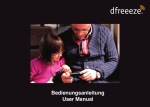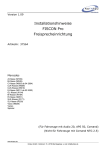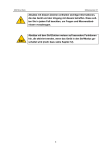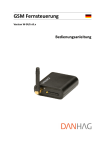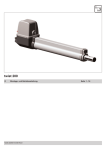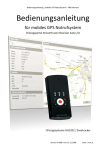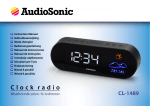Download dfreeeze parking heater remote control Installation guide
Transcript
Einbauanleitung Installation guide Sehr geehrte Kundin, sehr geehrter Kunde, wir bedanken uns für den Kauf der Standheizungs-Fernbedienung dfreeeze®. Das System ermöglicht Ihnen die komfortable Steuerung Ihrer Standheizung über das Internet. Zur DE Steuerung stehen Ihnen Apps für die Betriebssysteme Android und iOS zur Verfügung. Außerdem können Sie Ihre Standheizung über das Internet von jedem Smartphone, Tablet, PC oder Mac steuern. Diese Einbauanleitung ergänzt die Bedienungsanleitung und enthält alle Informationen, die Sie zum Einbau benötigen. Bitte bewahren Sie diese Anleitung sorgfältig (zum Beispiel im Bordbuch Ihres Fahrzeuges) auf. 2 Inhalt 1 Gefahren- und Warnhinweise.................................................................................................................................. 4 2Vorbemerkungen....................................................................................................................................................... 4 3Lieferumfang............................................................................................................................................................. 5 4 Einbau und Montage................................................................................................................................................. 5 4.1Mobilfunkempfänger................................................................................................................................................................. 5 DE 4.2Mobilfunkantenne..................................................................................................................................................................... 6 4.3Temperaturfühler...................................................................................................................................................................... 7 5Anschluss.................................................................................................................................................................. 8 5.1Adapterkabel............................................................................................................................................................................ 8 5.2 Verbaukonfigurationen........................................................................................................................................................... 11 6Bedienung................................................................................................................................................................ 20 6.1Testphase............................................................................................................................................................................... 20 7 Technische Merkmale............................................................................................................................................. 21 7.1Empfänger.............................................................................................................................................................................. 21 7.2Antenne.................................................................................................................................................................................. 22 3 DE 1 Gefahren- und Warnhinweise 2 Vorbemerkungen Der Einbau des dfreeeze® Empfängers darf ausschließlich Der dfreeeze® Empfänger ist vollständig betriebsbereit durch ausgebildetes Fachpersonal erfolgen. Versuchen und eignet sich zur Steuerung zahlreicher Standhei- Sie nicht, den dfreeeze® Empfänger oder dessen Zubehör zungen. zu reparieren. Die hier vorliegende Einbauanleitung beschreibt den Beachten Sie bitte immer diese Einbauanleitung und Einbau des dfreeeze® Systems mit verschiedenen Stand- insbesondere die enthaltenen Gefahren- und Warnhin- heizungen. weise. Jede Haftung, die auf einen Eingriff durch Im dfreeeze® Empfänger werden hauptsächlich für die ungeschultes Personal zurückzuführen ist, lehnt digades Automobilindustrie zertifizierte Komponenten verwendet. ab. Das Gerät ist ausschließlich zur Steuerung von Standheizungen vorgesehen und darf nicht für andere Zwecke verwendet werden. 4 3 Lieferumfang ●● Der Einbau erfolgt bevorzugt senkrecht mit den Steckverbindern nach unten, um das Das dfreeeze® System besteht aus: ●● ●● ●● Mobilfunkempfänger Eindringen von Kondenswasser zu vermeiden. ●● im Lieferumfang befindlichen Kabelbinder und Adapterkabelbaum inklusive zusätzlicher Klebesockeln erfolgen. (Beispiel siehe nächste Stecker ●● ●● Die Fixierung des Empfängers kann mit den Scheibenklebeantenne Einbau- und Bedienungsanleitung Montagematerial (Klebesockel, Kabelbinder) Seite). ●● DE Die Einbauposition des Empfängers sollte in der nachfolgenden Skizze markiert werden. 4 Einbau und Montage 4.1 Mobilfunkempfänger ●● Der Einbau des dfreeeze® Mobilfunkemp- ●● Bei vorhandenem T91/T100 Funkempfänger fängers muss im Fahrzeuginnenraum erfolgen. muss der Einbau in dessen Nähe erfolgen. Eine Übersicht zu den üblichen Verbauorten des T91/T100 Funkempfängers finden Sie unter www.dfreeeze.de/support 5 Befestigungsbeispiel dfreeeze® Mobilfunkempfänger 4.2 Mobilfunkantenne ●● Um einen bestmöglichen Empfang sicherzustellen, sollte die Mobilfunkantenne innen auf der Front- oder Heckscheibe möglichst mittig montiert werden. DE ●● Der Empfang ist optimal, wenn ein Abstand zu Karosserieblechteilen zwischen 15mm und 25mm eingehalten wird. ●● Alternativ kann die Mobilfunkantenne bei leicht verschlechterter Empfangsqualität auch seitlich an der Scheibe montiert werden. Sollte eine Montage der Antenne an den Fahrzeugscheiben nicht möglich sein, ist alternativ auch eine Montage im Fahrzeuginnenraum möglich. Hierbei ist mit einem leicht verschlechterten Empfangsverhalten zu rechnen. 6 Beim Aufkleben der Mobilfunkantenne an der Scheibe 4.3 Temperaturfühler sind die folgenden Punkte zu beachten: Der Temperaturfühler muss im Fahrzeuginnenraum ●● ●● Die Windschutzscheibe muss fett- und staubfrei verbaut werden. Suchen Sie je nach Fahrzeug einen sein. geeigneten Einbauort. Die Schutzfolie muss von der Antenne abgezogen werden und die Antenne an der Für eine möglichst genaue Ermittlung der Innenraumtem- gereinigten Stelle der Scheibe aufgeklebt peratur sollte der Temperatursensor: DE werden. ●● Bitte achten Sie auf ein knickfreies Verlegen ●● keiner direkten Sonneneinstrahlung ausgesetzt ●● nicht in der Nähe von Karrosserieteilen platziert sein des Kabels. ●● Das Kabel der Mobilfunkantenne ist ein sein, die einer direkten Sonneinstrahlung Hochfrequenzkabel, das nicht gekürzt werden ausgesetzt sind darf. ●● Wenn das Kabel zu lang ist, sollte es ringförmig aufgewickelt werden. Der Ringdurchmesser ●● nicht direkt vor einem Lüftungsauslass platziert werden. sollte möglichst groß und auf keinen Fall kleiner als 60mm sein. Bitte beachten Sie, dass am W-Bus nur EIN Temperatursensor angeschlossen sein darf. Dies betrifft die Verbaukonfigurationen 1, 2 und 3, sofern im Fahrzeug bereits ein Webasto-Temperatursensor vorhanden ist. 7 5 Anschluss 5.1 Adapterkabel Der dfreeeze® Mobilfunkempfänger wird mit Ihrer Standheizung verbunden. Dazu liegen ein individiuell konfigurierbarer Kabeladapter sowie zusätzlich zwei Steckergehäuse bei. Mit den bereits angebrachten schwarzen DE Steckergehäusen ist der Kabeladapter zur Verwendung mit nachgerüsteten Webasto-Standheizungen sowie vieler ab Werk verbauter Standheizungen geeignet. Die getrennt beiliegenden blauen Steckergehäuse sind mit ab Werk verbauten Standheizungen oder als original Zubehör unter anderem von Volkswagen, Skoda und Seat kompatibel. Für den Anschluss an weitere Standheizungen müssen Pinbelegung Adapterkabel Pin X1 X2 1 2 3 X3 X4 12V W-Bus* je nach Verbaukonfiguration** 4 je nach Verbaukonfiguration** 5 frei GND 6 GND * Die W-Bus-Leitung ist je nach Verbaukonfiguration nicht immer durchgängig verbunden. ** Pin 3 und Pin 4 sind je nach Konfiguration entweder frei oder mit Schaltausgang und -eingang belegt. unter Umständen die Leitungen direkt verdrahtet werden. Weitere Informationen zum Einbau und Anschluss des dfreeeze® Systems mit fahrzeugspezfischen Informationen finden Sie unter www.dfreeeze.de/ support. 8 Lesen Sie die detaillierte Beschreibung der Verbaukonfigurationen auf den folgenden Seiten für nähere Informationen. Adapterkabel dfreeeze® X3 dfreeeze® Empfänger X4 Temperatursensor Tyco 1-1718346-2 Tyco 1-1241370-3 DE X1 X2 zusätzlicher Funkempfänger Standheizung schwarz: Tyco 1-1241370-3 schwarz: Tyco 170384-1 blau: VW 6Q0 972 706 blau: VW 6Q0 972 716 9 Vorbereiten des Adapterkabels Um das Adapterkabel möglichst universell einsetzbar zu gestalten, sind im Auslieferungszustand nicht alle Leitungen kontaktiert. Sie können daher Ihr Kabel je nach Verbaukonfiguration entsprechend anpassen. ●● Achten Sie darauf, dass die Führungsfeder am Steckkontakt in die zugehörige Führungsnut am Steckergehäuse eingeführt wird. ●● Achten Sie darauf, dass der Steckkontakt vollständig im Gehäuse eingerastet ist. ●● Versuchen Sie nicht, den Steckkontakt mit Gewalt in das Steckergehäuse einzuschieben. DE Stecken von Kontaktstiften in das Gehäuse Betrifft: Verbaukonfiguration 1-2; 4-71 Verbindung der W-Bus-Leitung (gelb) Betrifft: Verbaukonfiguration 1-31 Beachten Sie beim Steckenn der Kontaktstifte die folgenden allgemeinen Hinweise: Zum Verbinden der gelben W-Bus-Leitung zwischen Stecker X2 und X3: ●● Entfernen Sie die Transportsicherung und ziehen Sie die Isolierschläuche von den Kontakten ab. ●● Achten Sie auf die korrekte Pinbelegung; die Kammern sind am Steckergehäuse nummeriert ●● Ziehen Sie die beiden gelben Leitungsenden aus der mittleren Bündelung heraus ●● ●● Ziehen Sie die Isolierung der Leitung ab Stecken Sie zuerst das eine, danach das Die jeweilige Pinbelegung finden Sie in der andere Leitungsende in den beiliegenden Detailbeschreibung auf den folgenden Seiten. Stoßverbinder und verpressen Sie beide Seiten nacheinander mit einer geeigneten Zange. 10 1 Zur Erläuterung der Verbaukonfigurationen siehe Seiten 11 bis 18 Anbringen der blauen Steckergehäuse (VW) Betrifft: Verbaukonfiguration 4-51 5.2 Verbaukonfigurationen Bitte beachten Sie, dass der dfreeeze® Empfänger je Für die Verwendung des dfreeeze® mit ab Werk verbauten nach Fahrzeug für eine korrekte Funktion des dfreeeze® oder als original Zubehör nachgerüsteten Standhei- Systems entsprechend der Verbaukonfiguration initiali- zungen unter anderem von Volkswagen, Skoda und Seat siert werden muss. ist es erforderlich die Steckergehäuse X1 und X2 gegen die beiliegenden blauen Gehäuse zu ersetzen. Eine Schritt-für-Schritt-Anleitung zum Umbau des Kabeladapters zur Verwendung mit den blauen VW-Steckergehäusen finden Sie unter www. dfreeeze.de/support Sichern der nicht benötigten Leitungsenden Betrifft: alle Verbaukonfigurationen ●● DE Verbaukonfiguration Seite 1 - Stand Alone mit Taster 12 2 - Stand Alone mit Vorwahluhr 12 3 - Telestart über W-Bus 14 4 - Telestart VW MQB (LIN) 16 5 - Telestart VW PQ (W-Bus) 16 6 - Empfänger analog (Uhr) 18 7 - Empfänger analog (Taster) 18 Isolieren Sie nach dem Einbau und Test des dfreeeze® Systems nicht benötigte Leitungsenden beispielsweise mit Isolierband. Bitte informieren Sie Ihren Kunden über die korrekte Verbaukonfiguration. 11 Verbaukonfigurationen 1 & 2 Die Verbaukonfigurationen 1 & 2 beschreiben den Vorbereitung Adapterkabel ●● Anschluss des dfreeeze® Empfängers an eine Webasto enden mit dem mitgelieferten Stoßverbinder Standheizung mit W-Bus als alleinige Fernbedienungsmöglichkeit sowie die Kombination mit Taster bzw. Uhr. wie im Kabelplan rechts dargestellt (Pin 2). ●● Kontaktieren Sie den Stecker X3 wie im Kabelplan rechts dargestellt. DE Verbaukonfiguration 1: Stand Alone mit Taster Beachten Sie bei der Vorbereitung des Kabels die Hinweise auf Seite 10. Beliebige Standheizung, die wie nachfolgend beschrieben konfiguriert ist. Schaltausgang - Pin 3* 12V Dauersignal (z.B. LED Taster) Schalteingang - Pin 4* 12V Schaltimpuls Verbaukonfiguration 2: Stand Alone mit Uhr Beliebige Standheizung, die wie nachfolgend beschrieben konfiguriert ist. Schaltausgang - Pin 3* 12V Dauersignal Schalteingang - Pin 4* 12V Dauersignal *Die Angaben beziehen sich auf die Signale am 12 Verbinden Sie die beiden gelben Leitungs- dfreeeze® Empfänger (Stecker X3). Anschluss dfreeeze® Empfänger ●● Verbinden Sie die Steckverbinder mit den jeweiligen Geräten wie in der Systemdarstellung gezeigt. Taster/Uhr Webasto frei Kabelbaum Webasto Adapterkabel 9021440B dfreeeze® Temperatursensor Webasto dfreeeze® Empfänger Standheizung Systemdarstellung Standheizung / dfreeeze® Temperatursensor dfreeeze® DE Adapterkabel dfreeeze® X1 X2 X3 X4 1 2 3 4 5 6 1 2 3 4 5 6 1 2 3 4 5 6 1 2 3 frei Kabelbaum Webasto dfreeeze® Empfänger Temperatursensor dfreeeze® 13 Verbaukonfiguration 3 Vorbereitung Adapterkabel Die Verbaukonfiguration 3 beschreibt den Anschluss des ●● Standheizung mit bereits vorhandenem wie im Kabelplan rechts dargestellt. Funkemp- fänger T91/T100, der über W-Bus an die Standheizung ●● angeschlossen ist. Zudem ist die Konfiguration auch DE Verbinden Sie die beiden gelben Leitungsenden mit dem mitgelieferten Stoßverbinder dfreeeze® Empfängers an eine nachgerüstete Webasto Kontaktieren Sie den Stecker X1 wie im Kabelplan rechts dargestellt. möglich bei ab Werk verbauten Standheizungen der Beachten Sie bei der Vorbereitung des Kabels die Hinweise auf Seite 10. Marken Ford, Peugeot, Citroen und Landrover mit vorhandenem T91/T100 Funkempfänger. Anschluss dfreeeze® Empfänger Verbaukonfiguration 3 Telestart über W-Bus Nachgerüstete Webasto-Standheizungen mit vorhandenem Funkempfänger T91/T100 und W-Bus ●● Verbinden Sie die Steckverbinder mit den jeweiligen Geräten wie in der Systemdarstellung gezeigt. Pin 2* W-Bus *Die Angaben beziehen sich auf die Signale am dfreeeze® Empfänger (Stecker X3). 14 Taster/Uhr Webasto Telestart T91/T100 Kabelbaum Webasto Adapterkabel 9021440B dfreeeze® Temperatursensor Webasto dfreeeze® Empfänger Standheizung Systemdarstellung Standheizung / dfreeeze® Temperatursensor dfreeeze® DE Adapterkabel dfreeeze® X1 X2 X3 X4 1 2 3 4 5 6 1 2 3 4 5 6 1 2 3 4 5 6 1 2 3 Telestart T91/T100 Kabelbaum Webasto dfreeeze® Empfänger Temperatursensor dfreeeze® 15 Verbaukonfigurationen 4 & 5 *Die Angaben beziehen sich auf die Signale am dfreeeze® Empfänger (Stecker X3). Die Verbaukonfigurationen 4 & 5 beschreiben den Anschluss des dfreeeze® Empfängers an eine Original Ist kein Rückmeldesignal an Pin 4 an Stecker X3 vorhanden, kann die einwandfreie Funktion des dfreeeze® nicht gewährleistet werden. VW Standheizung (ab Werk verbaut oder als original Zubehör nachgerüstet). DE Verbaukonfiguration 4: Telestart VW MQB LIN Fahrzeuge basierend auf MQB (z.B. VW Golf VII, Vorbereitung Adapterkabel ● Zum Anschluss einer orginal VW Standheizung müssen die Stecker X1 und X2 gegen die Skoda Oktavia III) Schaltausgang - Pin 3* 12V Dauersignal Schalteingang - Pin 4* 12V Dauersignal blauen VW Stecker ausgetauscht werden. ● Kontaktieren Sie die Stecker X1 und X3 wie im Kabelplan rechts dargestellt. (zur Rückmeldung) Beachten Sie bei der Vorbereitung des Kabels die Hinweise auf Seite 10. Verbaukonfiguration 5: Telestart VW PQ W-Bus Fahrzeuge basierend auf der PQ-Plattform (z.B. VW Golf VI, VW Touran) 16 Anschluss dfreeeze® Empfänger ● Schaltausgang - Pin 3* 12V Schaltimpuls Schalteingang - Pin 4* 12V Dauersignal jeweiligen Geräten wie in der Systemdar- (zur Rückmeldung) stellung rechts gezeigt. Verbinden Sie die Steckverbinder mit den Telestart T91/T100 VW dfreeeze® Empfänger Standheizung VW Systemdarstellung Standheizung / dfreeeze® Adapterkabel Kabelbaum Fahrzeug dfreeeze® Temperatursensor dfreeeze® DE Adapterkabel dfreeeze® X1 X2 X3 X4 1 2 3 4 5 6 1 2 3 4 5 6 1 2 3 4 5 6 1 2 3 Telestart T91/T100 VW Kabelbaum Fahrzeug dfreeeze® Empfänger Temperatursensor dfreeeze® 17 Verbaukonfigurationen 6 & 7 *Die Angaben beziehen sich auf die Signale am dfreeeze® Empfänger (Stecker X3). Die Verbaukonfigurationen 6 & 7 beschreiben den Anschluss des dfreeeze® Empfängers an eine beliebige Ist kein Rückmeldesignal an Pin 4 vorhanden, kann die einwandfreie Funktion des dfreeeze® nicht gewährleistet werden. Standheizung mit Schaltaus und -eingang, die wie nachfolgendbeschriebenkonfiguriertsind. DE Verbaukonfiguration 6: Empfänger analog Uhr Beliebige Standheizung, die wie nachfolgend beschriebenkonfiguriertist. Vorbereitung Adapterkabel ● Schaltausgang - Pin 3* 12V Dauersignal Schalteingang - Pin 4* 12V Dauersignal Kabelplan rechts dargestellt. Beachten Sie bei der Vorbereitung des Kabels die Hinweise auf Seite 10. (zur Rückmeldung) Verbaukonfiguration 7: Empfänger analog Tast- Anschluss dfreeeze® Empfänger er Beliebige Standheizung, die wie nachfolgend beschriebenkonfiguriertist. ● Verbinden Sie die Steckverbinder mit den jeweiligen Geräten wie in der Systemdar- Schaltausgang - Pin 3* 12V Schaltimpuls Schalteingang - Pin 4* 12V Dauersignal (zur Rückmeldung) 18 Kontaktieren Sie den Stecker X3 wie im stellung rechts gezeigt. dfreeeze® Empfänger Standheizung ●● Systemdarstellung Standheizung / dfreeeze® Adapterkabel Kabelbaum Standheizung dfreeeze® Temperatursensor dfreeeze® DE Adapterkabel dfreeeze® X1 X2 X3 X4 1 2 3 4 5 6 1 2 3 4 5 6 1 2 3 4 5 6 1 2 3 frei Kabelbaum Standheizung dfreeeze® Empfänger Temperatursensor dfreeeze® 19 DE 6 Bedienung 6.1 Testphase Zur Benutzung des dfreeeze® Systems muss entweder Für einen Funktionstest nach erfolgtem Einbau steht auf einem geeigneten Smartphone (Android oder iOS) Ihnen als Werkstatt einmalig eine kostenlose 7-tägige eine App installiert oder über jeden gängigen Internetbro- Testphase zur Verfügung. wser (Mozilla Firefox, Google Chrome, Internet Explorer Geben Sie dazu bei der Initialisierung des Gerätes den ab Version 10, Safari, Opera) unter app.dfreeeze.de auf- Verification Key „123456“ ein. gerufen werden: (siehe auch Kap. 5 und Bedienungsanleitung Kap. 3.3) Machen Sie es sich einfach und scannen Sie den QR-Code – Sie werden automatisch zur richtigen App weitergeleitet. Die Benutzung der App ist in der Anwendung im Bereich „Info“ sowie in der Bedienungsanleitung beschrieben. 20 7 Technische Merkmale 7.1 Empfänger Übertragungsbänder: GSM (850 MHz), EGSM (900 MHz), DCS (1800 MHz), PCS (1900 MHz) Busanbindung: W-Bus Betriebsspannung: 12 V DC (9 bis 16 V DC) Ruhestromaufnahme: < 5 mA (Standby Mode) Max. Stromaufnahme (GSM-Burst) : ca. 800 mA (12 V DC) Max. zulässige Absicherung : 5A Arbeitstemperatur: -40°C bis +85°C Anschlüsse: Antenneneinbaustecker: FAKRA, Code D, Farbe Bordeaux, 50 Ω Abmessungen B x H x T [mm] 65 x 98 x 24 DE Systemeinbaustecker: 6-polig, Tyco, 1-1241370-3 : Gewicht: ca. 70 g Schutzart: IP43 21 Pinbelegung Empfänger 6 ... 1 1 – 12V 4 – Schalteingang 2 – W-Bus 5 – frei 3 – Schaltausgang 6 – Masse (GND) DE 7.2 Antenne Übertragungsbänder : GSM (850 MHz), EGSM (900 MHz), DCS (1800 MHz), PCS (1900 Impedanz : 50Ω Gain : 2,14 dBi Arbeitstemperatur : -40°C bis +85°C Kabel : Typ: RG174, Länge 2,5 m Kupplung : FAKRA, Code D, Farbe Bordeaux Abmessungen B x H x T [mm] : 119,0 x 14,8 x 6,7 Gewicht : 13 g MHz) 22 Für Ihre Notizen DE 23 Dear customer, Thank you for purchasing the dfreeeze® parking heater remote control. With this system, you can easily control your parking heater via the Internet with the aid of apps for android and iOS operating systems. You can also control your parking heater via the internet using any smart phone, tablet, PC or Mac. EN This installation guide supplements the user manual and contains everything you need to know to install the system. Please keep this manual in a safe place (for example, in your vehicle logbook). 24 Content 1 Hazard information and warnings......................................................................................................................... 26 2 Preliminary remarks................................................................................................................................................ 26 3 Product contents..................................................................................................................................................... 27 4 Installation and mounting...................................................................................................................................... 27 4.1 Mobile receiver....................................................................................................................................................................... 27 4.2 Mobile antenna....................................................................................................................................................................... 28 4.3 Temperature sensor............................................................................................................................................................... 29 5Connecting.............................................................................................................................................................. 30 5.1 Adapter cable......................................................................................................................................................................... 30 5.2 Installation configurations....................................................................................................................................................... 33 EN 6Operating................................................................................................................................................................. 42 6.1 Test phase.............................................................................................................................................................................. 42 7 Technical features................................................................................................................................................... 43 7.1Receiver................................................................................................................................................................................. 43 7.2Antenna.................................................................................................................................................................................. 44 25 EN 1 Hazard information and warnings 2 Preliminary remarks The dfreeeze® receiver may only be installed by a The dfreeeze® receiver is fully operational and can be qualified professional. Please do not attempt to repair the used to control a large number of parking heaters. dfreeeze® receiver or any of the accessories yourself. This installation guide describes the installation of the Please always refer to this user manual and in particular receiver in Volkswagen vehicles with parking heaters to the hazard information and warnings contained herein. installed ex works or retrofitted as original VW acces- Digades shall not assume any liability for consequences sories. arising as a result of action by unqualified individuals. The dfreeeze® receiver primarily comprises components The device is intended solely as a means of controlling parking heaters and may not be used for other purposes. 26 certified in line with automotive standards. 3 Product contents ●● The dfreeeze® mobile receiver should preferably be installed facing in a downward The dfreeeze® system comprises: ●● ●● ●● ●● ●● direction perpendicular to the plug connections Mobile receiver in order to prevent condensation entering the Windscreen antenna adapter cable incl. connectors device. ●● The receiver may be secured in place using User manual and installation guide the cable strap and adhesive mount included Mounting material (adhesive mount, cable with the device. (An example is shown on the strap) next page) ●● 4 Installation and mounting The installation position should be indicated on EN the following drawing. 4.1 Mobile receiver ●● The installation of the dfreeze® mobile radio ●● In the event of existing T91/T100 radio receiver must take place inside of the vehicle receivers, this must take place in its vicinity You will find an overview of the standard installation locations for the T91 receiver at www.dfreeeze.de/support 27 4.2 Mobile antenna ●● In order to ensure the best possible reception, the mobile antenna should be mounted as close as possible to the centre of the inside of the front or back windscreen. ●● The optimum reception will be obtained where a distance of between 15 mm and 25 mm to all parts of the bodywork is maintained. EN ●● Alternatively, the mobile antenna may also be mounted to the side of the windscreen, although this will result in a slight reduction in reception quality. Should it not be possible to mount the antenna on the vehicle windscreen, it may alternatively be mounted in the interior of the vehicle, however this will probably result in a slight reduction in reception quality. 28 Please have regard to the following points when affixing 4.3 Temperature sensor the mobile antenna to the windscreen: The temperature sensor must be installed in the interior ●● ●● ●● The windscreen must be free of any grease or of the vehicle. You should select an appropriate location, dust. depending on the type of vehicle concerned. The protective film must be removed from the antenna and the antenna affixed to a clean In order to ensure the greatest possible precision in area of the windscreen. measuring the temperature inside the vehicle, the temper- Please ensure that the cable is laid flat without ature sensor should not be: EN any kinks. ●● The cable for the mobile antenna is a high-frequency cable and may not be shortened. ●● ●● ●● Installed in close proximity to any parts of the bodywork that is exposed to direct sunlight. If the cable is too long, it should be wound up into coils, keeping the diameter of the coils as Exposed to direct sunlight ●● placed directly in front of an air outlet. large as possible and no smaller than 60 mm. Please note that only ONE temperature sensor may be connected to the W-bus. This concerns the installation configurations 1, 2 and 3, provided a Webasto temperature sensor is already present in the vehicle. 29 5 Connecting 5.1 Adapter cable The dfreeeze® mobile radio receiver is connected with your parking heating. In addition, there is an individually configurable cable adapter and additional two plug housings. With the black plug housings already attached, the cable adapter is suitable for use with retro- EN Pin assignment of the adapter cable Pin X1 X2 X3 1 2 W-Bus* fitted Webasto parking heaters as well as many parking 3 heaters installed ex works. depending on the installation configuration** 4 depending on the installation configuration** The separate enclosed blue plug housings are compatible X4 12V with parking heaters installed ex works or as original 5 free accessories, among others Volkswagen, Skoda and Seat. 6 GND GND For connection to other parking heaters, the lines must be wired directly in certain circumstances. * The W-bus cable is not always continuously connected depending on the installation configuration. ** Depending on the configuration, pin 3 and pin 4 are More information about the installation and connection of the dfreeeze® system with partly vehicle-specific information can be found at www. dfreeeze.de/support. 30 either free or occupied with switching output or input. Read the detailed description of the installation configuration on the following pages for more information. Adapter cable dfreeeze® X3 dfreeeze® receiver X4 Temperature sensor Tyco 1-1718346-2 Tyco 1-1241370-3 EN X1 X2 additional radio receiver Parking heater black: Tyco 1-1241370-3 blue: VW 6Q0 972 706 black: Tyco 170384-1 blue: VW 6Q0 972 716 31 ●● Preparation of the adapter cable Note the tongue on the plug contact as well as the associated guide groove on the plug To make the adapter cable as universally applicable as housing. ●● possible, not all lines are connected in the delivery state. Depending on the installation configuration, you must Ensure that the plug contact is completely seated in the housing. ●● therefore prepare your cable accordingly. Do not attempt to insert the plug contact into the plug housing with force. Insertion of contact pins into the housing Concerns: Installation configuration 1-2; 4-71 EN When plugging in the contact pins, note the following general information: Connection with the W-bus cable (yellow) Concerns: Installation configuration 1-31 To connect the yellow W-bus cable between plug X2 and X3: ●● Remove the transport lock and pull the insulating sleeve from the contacts. ●● Note the correct pin assignment; the chambers are numbered on the plug housing You can find the respective pin assignment in the detailed description on the following pages- ●● Pull both yellow cable ends out of the middle bundling ●● ●● Pull the insulation off of the cable First insert one cable end and then the other end of the cable into the accompanying butt connector and crimp both sides successively with suitable pliers. 32 Attaching the blue plug housing (VW) Concerns: Installation configuration 4-51 5.2 Installation configurations Please note that, depending on the vehicle, the receiver To use the dfreeeze® with parking heaters installed ex must be initialised according to the installation config- works or parking heaters retrofitted as original acces- uration in order to ensure a correct function of the sories, such as Volkswagen, Skoda and Seat, it is dfreeeze® system. Please also refer to the enclosed necessary to replace the plug housing X1 and X2 with the Instruction Manual in this regard. enclosed blue housing. A step-by-step instruction for retrofitting the cable adapter for use with the blue VW plug housing can be found at www.dfreeeze.de/support Secure the unused cable ends Concerns: all installation configurations 1 ●● After the installation and test of the dfreeeze® system, insulate the unused cable ends, for Installation configuration Page 1 - Stand Alone with button 34 2 - Stand Alone with pre-selection clock 34 3 - Telestart via W-bus 36 4 - Telestart VW MQB (LIN) 38 5 - Telestart VW PQ (W-bus) 38 6 - Receiver analogue (clock) 40 7 - Receiver analogue (button) 40 EN example with electrical tape. Please notify your customer correct installation configuration. of the 33 Installation configuration 1 & 2 *The information refers to the signals on the dfreeeze® receiver (plug X3). The installation configurations 1 & 2 describe the connection of the dfreeeze® receiver to a Webasto parking heater with W-bus as the only remote control possibility Preparation of the adapter cable ●● as well as the combination with buttons or a clock. Connect the two yellow cable ends with the supplied butt connectors as shown in the cable diagram to the right (pin 2). Installation config 1: Stand Alone with button EN ●● Any parking heater that is configured as described Connect the plug X3 as shown in the cable diagram on the right. below. Switching output - Pin 3* Note the information on page 32 when preparing the cable. 12V continuous signal (e.g. LED button) Switching input - Pin 4* 12V switching impulse Installation configuration 2: Stand Alone with clock Any parking heater that is configured as described below. 34 Switching output - Pin 3* 12V continuous signal Switching input - Pin 4* 12V continuous signal Connecting the dfreeeze® receiver ●● Connect the plug connector with the respective devices as shown in the system diagram to the right. Button / clock Webasto Webasto wiring harness Adapter cable 9021440B dfreeeze® Temperature sensor Webasto dfreeeze® receiver Parking heater System representation of the parking heater / dfreeeze® Temperature sensor dfreeeze® EN Adapter cable dfreeeze® X1 X2 X3 X4 1 2 3 4 5 6 1 2 3 4 5 6 1 2 3 4 5 6 1 2 3 free Wiring harness Webasto dfreeeze® Recipient Temperature sensor dfreeeze® 35 Installation configuration 3 The installation configuration 3 describes the connection Preparation of the adapter cable ●● supplied butt connectors as shown in the cable of the dfreeeze® receiver to a retrofitted Webasto parking heater with an already existing radio receiver T91/T100, diagram to the right. ●● which is connected to the parking heater via W-bus. In Connect the plug X1 as shown in the cable diagram on the right.. addition, the configuration is also possible for ex works-in- Note the information on page 32 when preparing the cable. stalled parking heaters from the brands Ford, Peugeot, Citroen and Landrover with the existing T91/T100 radio EN Connect the two yellow cable ends with the receiver. Connecting the dfreeeze® receiver Installation configuration 3 Telestart via W-bus Connect the plug connector with the respective devices as shown in the system diagram to the receiver T91/T100 and W-bus. right. Pin 2* W-Bus *The information refers to the signals on the dfreeeze® receiver (plug X3). 36 ●● Retrofitted Webasto parking heaters with existing radio Button / clock Webasto Telestart T91/T100 Webasto wiring harness Adapter cable 9021440B dfreeeze® Temperature sensor Webasto dfreeeze® receiver Parking heater System representation of the parking heater / dfreeeze® Temperature sensor dfreeeze® EN Adapter cable dfreeeze® X1 X2 X3 X4 1 2 3 4 5 6 1 2 3 4 5 6 1 2 3 4 5 6 1 2 3 Telestart T91/T100 Wiring harness Webasto dfreeeze® Receiver Temperature sensor dfreeeze® 37 Installation configuration 4 & 5 *The information refers to the signals on the dfreeeze® receiver (plug X3). The installation configurations 4 & 5 describe the connection of the dfreeeze® receiver to an original VW If no feedback signal to pin 4 on plug X3 is present, the proper function of the dfreeeze® cannot be guaranteed. parking heater (installed ex works or retrofitted as an original accessory). Installation configuration 4: Telestart VW MQB Vehicles EN based on MQB (e.g. VW Golf VII, Preparation of the adapter cable ● To connect an original VW parking heater, the plugs X1 and X2 must be replaced with the Skoda Oktavia III) Switching output - Pin 3* 12V continuous signal Switching input - Pin 4* 12V continuous signal blue VW plugs. ● Connect the plugs X1 and X3 as shown in the cable diagram on the right. (for response) Note the information on page 32 when preparing the cable. Installation configuration 5: Telestart VW PQ Vehicles based on the PQ-platform (e.g. VW Golf VI, VW Touran) 38 Connecting the dfreeeze® receiver ● Switching output - Pin 3* 12V switching impulse Switching input - Pin 4* 12V continuous signal devices as shown in the system diagram to the (for response) right. Connect the plug connector with the respective Telestart T91/T100 VW dfreeeze® receiver VW parking heater System representation of the parking heater / dfreeeze® Adapter cable Vehicle wiring harness dfreeeze® Temperature sensor dfreeeze® EN Adapter cable dfreeeze® X1 X2 X3 X4 1 2 3 4 5 6 1 2 3 4 5 6 1 2 3 4 5 6 1 2 3 Telestart T91/T100 VW Wiring harness Vehicle dfreeeze® Receiver Temperature sensor dfreeeze® 39 Installation configuration 6 & 7 *The information refers to the signals on the dfreeeze® receiver (plug X3). The installation configurations 6 & 7 describe the connection of the dfreeeze® receiver to any parking heater If no feedback signal to pin 4 is present, the proper function of the dfreeeze® cannot be guaranteed. withswitchingoutputandinput,whichareconfiguredas described below. Inst. configuration 6: Receiver analogue clock EN Any parking heater that is configured as described below. Preparation of the adapter cable ● diagram on the right. Switching output - Pin 3* 12V continuous signal Switching input - Pin 4* 12V continuous signal Note the information preparing the cable. (for response) Inst. configuration 7: Receiver analogue button Any parking heater that is configured as described on page 32 when Connecting the dfreeeze® receiver ● Connect the plug connector with the respective devices as shown in the system diagram to the below. Switching output - Pin 3* 12V switching impulse Switching input - Pin 4* 12V continuous signal (for response) 40 Connect the plug X3 as shown in the cable right. dfreeeze® receiver Parking heater System representation of the parking heater / dfreeeze® Adapter cable Parking heater wiring harness dfreeeze® Temperature sensor dfreeeze® EN Adapter cable dfreeeze® X1 X2 X3 X4 1 2 3 4 5 6 1 2 3 4 5 6 1 2 3 4 5 6 1 2 3 free Wiring harness Parking heater dfreeeze® Receiver Temperature sensor dfreeeze® 41 EN 6 Operating 6.1 Test phase In order to enable the use of the dfreeeze® system, an As a car service station, you will have the benefit of a free app must either be installed on a suitable smart phone 7-day test phase for functional testing purposes following (Android oder iOS) or opened using an established the successful installation of the receiver. internet browser (Mozilla Firefox, Google Chrome, In order to take advantage of this feature, please enter the Version 10 of Internet Explorer and above, Safari, Opera) verification key “123456” upon initialising of the device. browsing to the address app.dfreeeze.de. (see also Point 5, and Point 3.3 of the user manual) Simply scan the QR code – and you will be automatically be directed to the correct app. The “Info” section and the user manual explain how to use the app. 42 7 Technical features 7.1 Receiver Transmission bands : GSM (850 MHz), EGSM (900 MHz), DCS (1800 MHz), PCS (1900 MHz) Bus connection : W-Bus Operating voltage : 12 V DC (9 to 16 V DC) Standby current : < 5 mA (standby mode) Max. current consumption (GSM burst) : Approx. 800 mA (12 V DC) Max. permissible fuse protection : 5A Working temperature : Connectors: EN -40°C to +85°C Antenna plug connector: FAKRA, Code D, burgundy-coloured, 50 Ω System plug connector: 6-pin, Tyco, 1-1241370-3 Dimensions B x H x T [mm] : 65 x 98 x 24 Weight: Approx. 70 g Protection rating IP43 : 43 Pin assignment for receiver 6 ... 1 EN 1 – 12V 4 – Switch input 2 – W-Bus 5 – Open 3 – Switch output 6 – Ground (GND) 7.2 Antenna Transmission bands : GSM (850 MHz), EGSM (900 MHz), DCS (1800 MHz), PCS (1900 Impedance : 50Ω Gain : 2.14 dBi Working temperature : -40°C to +85°C Cable : Type: RG174, length: 2.5 m Connector : FAKRA, Code D, burgundy-coloured Dimensions B x H x T [mm] : 119.0 x 14.8 x 6.7 Weight : 13 g MHz) 44 For your notes EN 45 DE 46 Wir wünschen Ihnen viel Spaß mit Ihrem dfreeeze ® System. We hope you enjoy using your dfreeeze ® System. Digades GmbH Äußere Weberstraße 20 02763 Zittau GERMANY http://www.dfreeeze.de http://www.dfreeeze.com [email protected] Änderungen vorbehalten Subject to change without prior notice © 2014 Alle Rechte vorbehalten © 2014 All rights reserved Picture credits cover: © AntonioDiaz - Fotolia.com Page 47: © contrastwerkstatt - Fotolia.com

















































